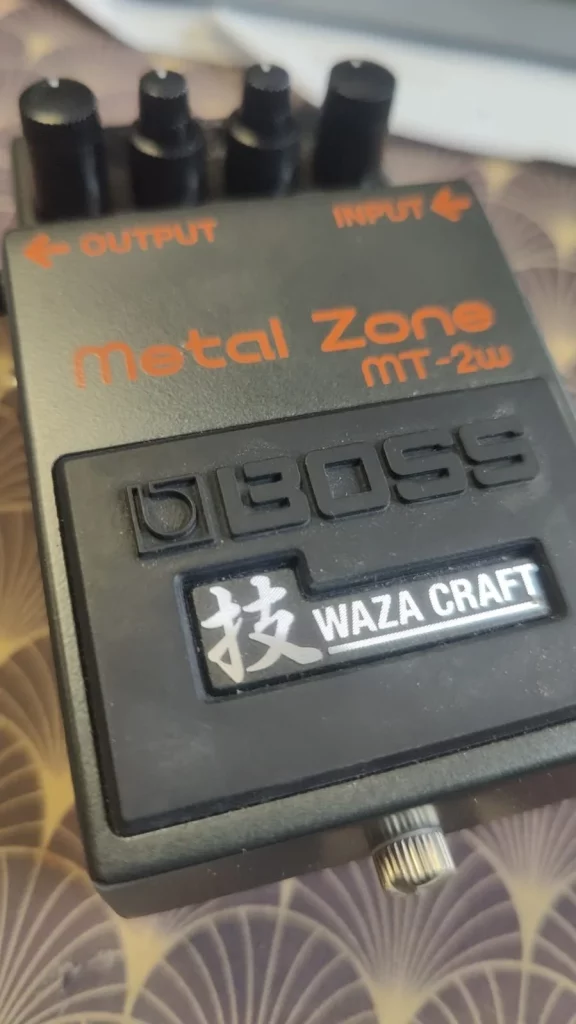Boss MT-2w Metal Zone

The Metal Zone by Boss is, in fact, their second best selling dirt pedal ever, only to be surpassed by the DS-1 distortion. Since it was released in 1991, over a million units have sold worldwide. Those are incredible numbers, given that the DS-1 is a widespread guitar distortion pedal, one that often gets compared to the Tube Screamer, and the Metal Zone is a fair bit more niche.
It’s famous – or infamous, depending on where you look. Mock up memes of pedal boards with a dozen Metal Zones, weird internet videos, along with several claims this is the worst pedal ever surely add to that. Since I’m a self confessed cork sniffer, the pedestrian Metal Zone was, of course, not good enough for the advanced tastebuds in my ear canals. What AMG is to Mercedes, Waza Craft is to Boss – and the MT-2 has of course been Waza’ed – and so I got myself one of these. Apart from the Waza logo on the rubber foot switch bumper, there is a small switch, its positions labeled S and C, and the screw to access the battery is silver instead of black – just like the rear view mirrors on the Audi RS series cars.
Apart from that, the Waza and Vanilla versions are identical in appearance. You get your usual volume and gain, plus two stacked pots for the EQ. Those four rings control bass, treble and parametric mids, which go from 200Hz to 5kHz. The little switch lets you select S for standard and C for custom – however, even the standard version supposedly runs better than the normal pedal.
I won’t say anything about the enclosure or the build quality. It’s a Boss pedal. Everyone has seen one of them. I personally dislike the side jacks and the design of the foot switch, but there are enough people out there who love them for their design, so I do consider my personal opinion either very personal or very elite. The one thing I will remark upon is that the matte finish is done very well and conveys equal parts of a noble and an evil vibe.
Plugging his thing into my setup honestly started off as a big surprise!
I thought this would be something akin to the Bliss Factory or the Fjord Fuzz Fenris, in the sense that you get the feeling of riding a race car down an ancient cobblestone road, with the accelerator pedal stuck to the floor and your co-pilot hysterically screaming obscenities instead of navigational instructions.
Instead, it feels more like a hot-rodded golf cart with the accelerator stuck and you’re shooting down the fairway with your co-pilot merely shouting in a mild panic.
I’m pretty sure the EQ is post drive, and it’s working remarkably well for bass. The bass knob does not really bring thunder down low, but when you max it out, the tone suck does not feel half as bad as I thought – I even need to go as far and say it’s tolerable. Because it is.
The parametric mids can be used to either push a bit more down low (for mids, that is) in 200-500Hz to increase the throat size for the bark, or it can be used to tame the metallic clank that rings through – with the mids knob turned down a bit and the frequency knob about two thirds up.
Of course you could also use the knob to actually increase the metallic bite, if that is your thing. Go ahead, I won’t judge you.
The treble knob controls the squealing and shrieking of the sound and I liked it best when applying a bit of a cut at around 10 o’clock.
The most interesting knob, of course, is the gain knob.
The pedal does not only pass signal with gain at zero, it also gets you low gain distortion.
There is no clean tone in the Metal Zone.
Travelling through the gain, I start from that low gain distortion at zero, which increases in a linear fashion until about 10 o’clock. That is the point where things get real. Put on your vest with the metal band patches. And maybe your earplugs.
Two things happen simultaneously. The amount of gain I get from here out can only be described as heavy distortion and a gentle compression sets in.
That gentle squeeze is as subtle as a sledge hammer to the face – blink and you miss it, and you barely feel a thing. The way it sets in and works is just as delicate as an anvil.
Your signal gets squashed in a way that will make most dedicated compressor pedals on the market flash their lights yellow with envy.
When I ride the gain at noon or past and set the level just 1dB below the threshold of my comp, the comp will idle around, no matter what I do.
The pedal does show some dynamic reaction to how hard you play it and it also clears up unexpectedly well with the basses volume knob, but that distortion and compression give you an amount of sustain that has to be measured with a calendar instead of a stop watch.
If you’re looking for note separation and the timbre of your boutique pickups well represented, you’re asking a medieval blacksmith to repair a Rolex. There is no subtle here, there is all the gain you could ask for and then some to top it off, and a very efficient EQ to bring the mushy gain-goo that exits the pedal in the form your ears desire. The EQ forms the white hot signal with precise hammer blows – but no matter how precise a hammer blow is, it remains a hammer blow. This thing is not made to rock. This thing is made to metal.
It’s brutal. It’s rough. It’s coarse. It’s heavy.
It’s beautiful.